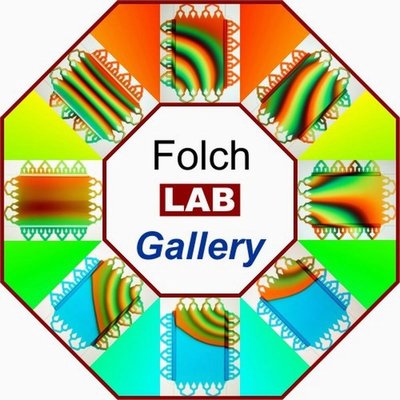January 10, 2008
Small is beautiful: Gallery celebrates the art of microfluids research
Albert Folch is a scientist who also happens to appreciate art. And many of the photos he’s taken through his microscope would look equally at home on the walls of a modern-art gallery. Crimson geometric shapes twist around on a white background. Colored pyramids surround a central rainbow. An eerie reddish landscape is known as “Microstructures on Mars,” while a spiraling pattern earned the caption “Van Gogh’s Cells.”
The University of Washington associate professor of bioengineering posted hundreds of these images in an online gallery and on his lab’s Web page. High-resolution versions of the images used in the slideshow are posted here.
“It’s a little like deep-ocean photos or pictures of outer space,” Folch said. “Images of the microscopic world are just intriguing, because this realm is outside the reach of the human eye.”
He began creating the free online gallery last year.
“They are really up there just for the heck of it,” he said, “just because I find them beautiful and I want to share them.”
Folch works in microfluidics, the study of liquids at scales smaller than a millimeter. His techniques may someday be used to build pocket-sized diagnostic tools — gadgets that could become the iPhones of the medical world, bringing emergency-room technology to patients. But accomplishing this is not easy. Scientists must figure out how to manipulate not just electrons but also liquids at the microscopic scale.
Researchers test these devices by running colored dyes through tiny machines or growing single cells on sheets of plastic and then photographing the results. It turns out that many of these pictures are strangely alluring. A 250-gigabyte hard drive in Folch’s office holds the best of the research images accumulated during his degree work at the University of Barcelona, and postdoctoral work at the Massachusetts Institute of Technology and Harvard Medical School.
Folch used Picasa, free photo-sharing software developed by Google, to create an online gallery of his favorites. The site currently includes more than 1,000 high-resolution images and about 50 videos. Most of the images have never been seen before. A typical journal article, he said, might show three or four color images among the hundreds or thousands possibilities. And some of the images are failed attempts that will never qualify for a scientific journal.
“I thought, if I don’t post them on the Web, no one will ever be able to see this,” Folch said. “The experiments may have failed, but the images are sometimes beautiful.”
###
For more information, contact Folch at (206) 685-2257 or afolch@u.washington.edu.

